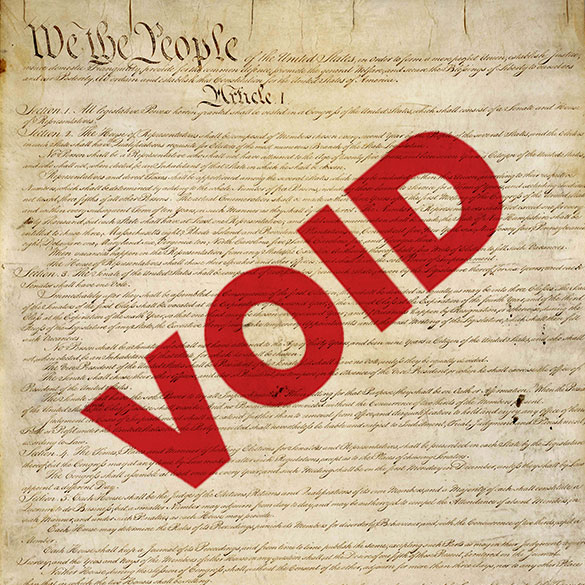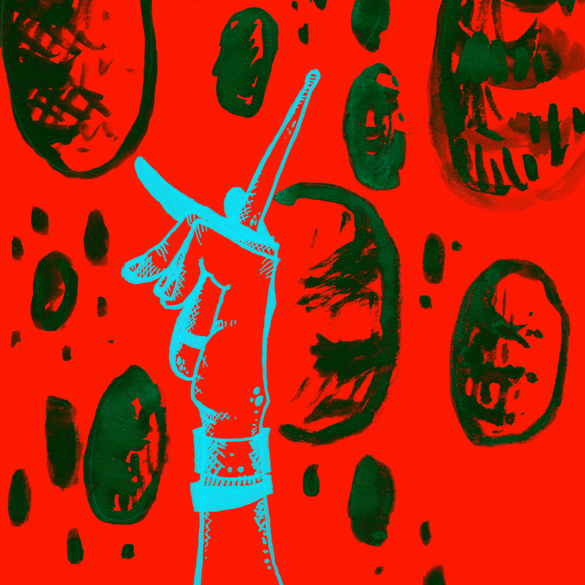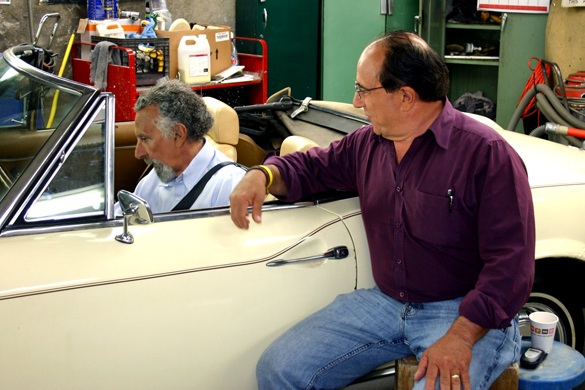“The First Amendment was intended to secure something more than an exercise in futility.”—Justice John Paul Stevens, dissenting in Minnesota Board for Community Colleges v. Knight (1984)
Living in a representative republic means that each person has the right to take a stand for what they think is right, whether that means marching outside the halls of government, wearing clothing with provocative statements, or simply holding up a sign. That’s what the First Amendment is supposed to be about.
Unfortunately, as I show in my book A Government of Wolves: The Emerging American Police State, through a series of carefully crafted legislative steps and politically expedient court rulings, government officials have managed to disembowel this fundamental freedom, rendering it with little more meaning than the right to file a lawsuit against government officials. In fact, if the court rulings handed down in the last week of February 2014 are anything to go by, the First Amendment has, for all intents and purposes, become an exercise in futility.
On February 26, the U.S. Supreme Court in a 9-0 ruling, held that anti-nuclear activist John Denis Apel could be prosecuted for staging a protest on a public road at an Air Force base, free speech claims notwithstanding, because the public road is technically government property.
Insisting that it’s not safe to display an American flag in an American public school, on February 27, the Ninth Circuit Court of Appeals ruled that school officials were justified when they ordered three students at a California public high school to cover up their patriotic apparel emblazoned with American flags or be sent home on the Mexican holiday Cinco de Mayo, allegedly out of a concern that it might offend Hispanic students.
On February 28, a federal court dismissed Marine veteran Brandon Raub’s case. Despite the fact that Raub was interrogated by Secret Service agents, handcuffed, arrested, subjected to a kangaroo court, and locked up in a mental facility for posting song lyrics and statements on Facebook critical of the government—a clear violation of his free speech rights—the court ruled that Raub’s concerns about the government were far-fetched and merited such treatment.
There you have it: three rulings in three days, from three different levels of the American judicial system, and all of them aimed at suppressing free speech. Yet what most people fail to understand is that these cases are not merely about the citizenry’s right to freely express themselves. Rather, these cases speak to the citizenry’s right to express their concerns about their government to their government, in a time, place and manner best suited to ensuring that those concerns are heard.
The First Amendment gives every American the right to “petition his government for a redress of grievances.” This amounts to so much more than filing a lawsuit against the government. It works hand in hand with free speech to ensure, as Adam Newton and Ronald K.L. Collins report for the Five Freedoms Project, “that our leaders hear, even if they don’t listen to, the electorate. Though public officials may be indifferent, contrary, or silent participants in democratic discourse, at least the First Amendment commands their audience.”
The challenge we face today, however, is that government officials have succeeded in insulating themselves from their constituents, making it increasingly difficult for average Americans to make themselves seen or heard by those who most need to hear what “we the people” have to say. Indeed, while lobbyists mill in and out of the White House and the homes and offices of Congressmen, the American people are kept at a distance through free speech zones, electronic town hall meetings, and security barriers. And those who dare to breach the gap—even through silent forms of protest—are arrested for making their voices heard.
This right to speak freely, assemble, protest and petition one’s government officials for a redress of grievances is front and center right now, with the U.S. Supreme Court set to decide five free speech cases this term, the first of which, U.S. v. Apel, was just handed down. The case was based upon claims brought by John Denis Apel, an anti-war activist who holds monthly protests at Vandenburg Air Force Base near Lompoc, California. While the Court did not uphold his conviction for trespassing on military property, they doubled down on the notion that the public is subject to the whims of military commanders in matters relating to use military property, even when it intersects with public property. The Court refused to rule on Apel’s First Amendment claims.
The Supreme Court is also set to decide McCullen v. Coakley, which will determine whether or not a Massachusetts law which restricts protests on public sidewalks near the entrances, exits, and driveways of abortion clinics in the state is constitutional. The facts of the case indicate that the law does not abide by a reasonable time, place, and manner restriction, and places an undue burden on protestors. However, it’s unclear which way the Court will rule, especially with their refusal to clarify matters in Apel.
Free speech can certainly not be considered “free” when expressive activities across the nation are being increasingly limited, restricted to so-called free speech zones, or altogether blocked, including in front of the Supreme Court’s own plaza. If citizens cannot stand out in the open on a public road and voice their disapproval of their government, its representatives and its policies, without fearing prosecution, then the First Amendment with all its robust protections for free speech, assembly and the right to petition one’s government for a redress of grievances is little more than window-dressing on a store window—pretty to look at but serving little real purpose.
The case of Harold Hodge is a particularly telling illustration of the way in which the political elite in America have sheltered themselves from all correspondence and criticism.
On a snowy morning in January 2011, Harold Hodge quietly and peacefully stood in the plaza area near the steps leading to the United States Supreme Court Building, wearing a 3’ X 2’ sign around his neck that proclaimed: “The U.S. Gov. Allows Police To Illegally Murder And Brutalize African Americans And Hispanic People.” There weren’t many passersby, and he wasn’t blocking anyone’s way. However, after a few minutes, a police officer informed Hodge that he was violating a federal law that makes it unlawful to display any flag, banner or device designed to bring into public notice a party, organization, or movement while on the grounds of the U.S. Supreme Court and issued him three warnings to leave the plaza. Hodge refused, was handcuffed, placed under arrest, moved to a holding cell, and then was transported to U.S. Capitol Police Headquarters where he was booked and given a citation.
According to the federal law Hodge is accused of violating, “It is unlawful to parade, stand, or move in processions or assemblages in the Supreme Court Building or grounds, or to display in the Building and grounds a flag, banner, or device designed or adapted to bring into public notice a party, organization, or movement.” The penalty for violating this law is a fine of up to $5,000 and/or up to 60 days in jail.
With the help of The Rutherford Institute, in January 2012, Hodge challenged the constitutionality of the statute barring silent expressive activity in front of the Supreme Court. A year later, in a strongly worded opinion, District Court Judge Beryl L. Howell struck down the federal law, declaring that the “the absolute prohibition on expressive activity [on the Supreme Court plaza] in the statute is unreasonable, substantially overbroad, and irreconcilable with the First Amendment.”
Incredibly, one day later, the marshal for the Supreme Court—with the approval of Chief Justice John Roberts—issued even more strident regulations outlawing expressive activity on the grounds of the high court, including the plaza. Hodge’s case, along with a companion case challenging the new regulations on behalf of a broad coalition of protesters, is now making its way through the appeals process. Ironically, it will be the justices of the U.S. Supreme Court who will eventually be asked to decide the constitutionality of their own statute, yet they have already made their views on the subject quite clear.
This desire to insulate government officials from those exercising their First Amendment rights stems from an elitist mindset which views “we the people” as different, set apart somehow, from the citizens they have been appointed to serve and represent. It is nothing new. In fact, the law under which Harold Hodge was prosecuted was enacted by Congress in 1949. In the decades since, interactions with politicians have become increasingly manufactured and distant. Press conferences, ticketed luncheons, televised speeches and one-sided town hall meetings held over the phone now largely take the place of face-to-face interaction with constituents.
Additionally, there has been an increased use of so-called “free speech zones,” designated areas for expressive activity used to corral and block protestors at political events from interacting with public officials. Both the Democratic and Republican parties have used these “free speech zones,” some located within chain-link cages, at various conventions to mute any and all criticism of their policies.
Clearly, the government has no interest in hearing what “we the people” have to say. Yet if Americans are not able to peacefully assemble for expressive activity outside of the halls of government or on public roads on which government officials must pass, the First Amendment has lost all meaning. If we cannot stand silently outside of the Supreme Court or the Capitol or the White House, our ability to hold the government accountable for its actions is threatened, and so are the rights and liberties that we cherish as Americans. And if we cannot proclaim our feelings about the government, no matter how controversial, on our clothing, or to passersby, or to the users of the world wide web, then the First Amendment really has become an exercise in futility.
George Orwell, always relevant to our present age, warned against this intolerance for free speech in 1945. As he noted:
The point is that the relative freedom which we enjoy depends of public opinion. The law is no protection. Governments make laws, but whether they are carried out, and how the police behave, depends on the general temper in the country. If large numbers of people are interested in freedom of speech, there will be freedom of speech, even if the law forbids it; if public opinion is sluggish, inconvenient minorities will be persecuted, even if laws exist to protect them… The notion that certain opinions cannot safely be allowed a hearing is growing. It is given currency by intellectuals who confuse the issue by not distinguishing between democratic opposition and open rebellion, and it is reflected in our growing indifference to tyranny and injustice abroad. And even those who declare themselves to be in favour of freedom of opinion generally drop their claim when it is their own adversaries who are being prosecuted.



